Dental Cleaning & Consultation
Preventative care is a foundation of dentistry. The Canadian Dental Association recommends visiting your dentist regularly – usually about twice yearly – for full cleanings, examinations, and consultations for potential treatment. Professional dental cleanings help remove built-up plaque that is not removable using conventional brushing and flossing. Often, dentists are also capable of identifying potential problems that patients are not yet able to see or feel. When you maintain regular preventative dental appointments, you can stave off decay and gum disease, as well as identify the beginnings of oral health problems before they become severe.

Did you know…that Canadians are less and less likely to visit the dentist as they age? Data from the Centers for Disease Control reports that only 57 percent of Canadians over age 65 visited the dentist in 2010. That compares to about 61 percent adults under age 65 and about 79 percent of children ages 2 to 17. Nonetheless, it is important to visit the dentist for cleanings and exams regardless of how long has passed since your most recent dental appointment.
Frequently Asked Questions
Do I really need to have my teeth professionally cleaned?
Yes. Even if you brush and floss after every meal and before bed, bacteria-harboring plaque can accumulate in the tiniest crevices, grooves and pits. Overtime, the teeth will begin to decay in those areas, which may result in pain and partial or total tooth loss.
What should I expect at my cleaning and exam consultation?
Your cleaning and consultation will consist of a visible examination of the teeth and gums. If you haven’t been to the dentist in a while, you may also require x-rays for a more comprehensive view of your teeth. You’ll also consult with your dentist about any oral health problems you may have been having or questions that you may have. The cleaning will follow, during which a dental hygienist will use special instruments to remove hardened plaque from your teeth. Finally, your teeth will be polished before your dentist discusses any treatment recommendations he or she may have for you.
What types of guidelines should I follow after my visit?
In between dental cleanings and consultations, be sure to maintain good oral habits at home. This includes daily flossing and brushing after meals. It’s also important to drink fluoridated water and use a fluoridated toothpaste.
Cosmetic dentistry is a branch of dentistry that is focused on increasing the visual aesthetics of your smile in addition to improving your dental health. By combining the science of dentistry with the beauty of aesthetics, cosmetic dentistry offers treatments that yield beautiful and healthy smiles. There are many different types of cosmetic dental treatments available, and you can either improve a single imperfect tooth or your entire smile.
Cosmetic dental treatments include:
-
- Composite bonding: composite resin is used to repair structural defects or to improve the color of your teeth.
-
- Composite fillings: composite resin is used to discreetly fill in small to medium areas of dental decay.
-
- Dental crowns & bridges: crowns are caps that fit over your tooth to protect it from damage or decay, and bridges are a series of crowns placed over gaps left by missing teeth and the adjacent teeth.
-
- Dental implants: implants are artificial tooth roots that are placed in the jawbone. They fuse with the surrounding bone and act as an anchor for a dental crown.
-
- Inlays & Onlays: Inlays is a large filling on the chewing surface of your molars, and Onlays are large fillings on the chewing surface and one or more cusps (points) of your tooth.
-
- Teeth Whitening: a specialized procedure that can remove years of stains from your teeth.
- Veneers: Thin, porcelain or composite resin shells that are adhered to the front of your teeth to correct size, shape, spacing, and color.
Did You Know?
Your smile is one of the first things people notice about you. In fact, a recent study has found that women with great smiles were rated as being more attractive than women will full makeup on, proving that a smile can be one of your greatest assets.
Frequently Asked Questions:
Am I a candidate for cosmetic dental services?
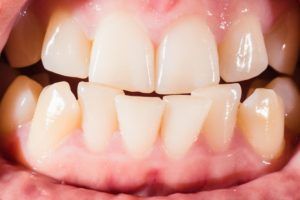
You may be a candidate for cosmetic dental services if you wish to improve the aesthetics of your smile. Cosmetic dentistry can correct the following dental imperfections:
-
- Discolored teeth
-
- Gapped teeth
-
- Crooked teeth
-
- Chipped or cracked teeth
-
- Irregularly shaped teeth
-
- Improperly sized or uneven teeth
- Missing teeth
Often times, there can be a slight overlap between restorative and cosmetic dental services. If you are in need of restorative dental services, you may also be a candidate for cosmetic dental services. To find out if cosmetic dental services are right for you, schedule a consultation with Dr. Claudia Wood of Danforth Dental Solutions today!
How do I know which cosmetic dental service to choose?
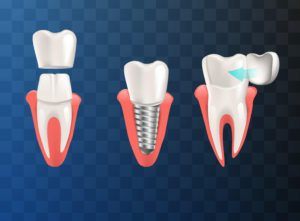
To help you decide on a cosmetic dental service, Dr. Wood will perform an oral exam, take dental x-rays, and ask you about your treatment goals. Then, she will make treatment recommendations for you. To help her help you decide on a cosmetic dental treatment, you will want to consider the following questions prior to your appointment:
-
- What is my budget?
-
- Am I willing to alter the natural surface of my teeth?
-
- Am I looking for a permanent or temporary solution?
-
- How long am I willing to communicate to treatment and maintenance?
-
- Am I happy with the size and shape of my teeth?
-
- Am I happy with the color of my teeth?
-
- Am I happy with the spacing and alignment of my teeth?
-
- If I could change one thing about my smile, what would that be?
- Do I have decayed, damaged, or missing teeth?
What can I expect when undergoing cosmetic dental treatment at Danforth Dental Solutions?
For all of our cosmetic dental treatments, Dr. Wood will make sure that you have all the necessary information prior to making any decisions regarding your treatments. With that being said, your exact expectations for cosmetic dental treatments will depend upon the type of treatment you choose.
Certain cosmetic dental treatments, such as teeth whitening or dental bonding, can be completed in a single dental appointment, are minimally invasive, and require no downtime. However, other cosmetic dental treatments, such as dental implants, require a more invasive form of treatment that requires multiple appointments and recovery time. This is why it is important to consider your level of commitment to cosmetic dental treatment.
What should I expect after undergoing cosmetic dental treatment at Danforth Dental Solutions?
Just as your individual expectations for cosmetic dental treatment will depend upon the type of treatment you select, the aftercare will also depend upon the type of treatment you choose. Some cosmetic dental treatments don’t require aftercare, while others may have extensive guidelines to follow. Any aftercare will be discussed with you prior to completing the treatment. In general, possible aftercare can include:
-
- Keeping the affected area clean and free of debris
-
- Taking any and all medications as directed
-
- Temporary diet modifications (soft foods diet)
- Altering your activities

How long does cosmetic dental treatment last?
How long your cosmetic dental treatment lasts will depend on the type of cosmetic dental treatment you’ve selected. Some cosmetic dental treatments are intended to be temporary solutions and will have shorter lifespans. For example, teeth whitening can last about six months to a couple years, while composite bonding can last up to five years. Other cosmetic dental treatments are permanent, but will require replacements eventually. For example, veneers can last about ten years, and dental implants can last about 10-20 years.
How much does cosmetic dental treatment cost?
The final cost of your cosmetic dental treatment will depend upon:
-
- Type of treatment (temporary vs. permanent)
-
- Extent of treatment (single tooth vs. entire mouth)
- Location in your mouth (front vs. back)
Because there is such a wide variety of cosmetic dental treatments, you are likely to find a treatment that meets your budget. Some cosmetic dental treatments are more affordable than others. Also if you have dental insurance, you may be able to obtain partial coverage for cosmetic dental treatments that may also fall under the category of restorative dental, such as composite fillings. Our office staff at Danforth Dental Solutions will help you determine your level of coverage and do everything we can to give you the smile of your dreams.
For dedicated and caring dental care, schedule a consultation with Dr. Claudia Wood of Danforth Dental Solutions. Danforth Dental Solutions is proud to serve Toronto and the surrounding areas.
General dentistry pertains to the prevention, identification, evaluation, diagnosis, and treatment of disorders or conditions that affect your teeth, gums, and the surrounding structures. The majority of general dentistry aims to be preventative and includes dental exams, dental x rays, professional teeth cleanings, and other preventative treatments like dental sealants or fluoride treatments. In cases where prevention can no longer be beneficial, then general dentistry takes on a restorative role to treat the issue at hand and restore your teeth to their former, healthy state. Because general dentists do not practice within one area of speciality, they have a vast expanse of dental knowledge and can perform many different dental procedures.

Did You Know?
Even if you are not having any symptoms, you may still have a dental disorder. Many dental disorders do not produce symptoms until they are in the advanced stages. This is why regular dental checkups are so important because they increase the chances of your dentist identifying and treating the problem before it gets worse.
Frequently Asked Questions:
Am I a candidate for general dentistry?
Yes, everyone is a candidate for general dentistry because most of general dentistry works to prevent the occurrence and progression of dental disorders. No matter your age or current dental health, preventative measures can always be used with general dentistry to keep your teeth healthy. You may also be a candidate for general dental services if you have dental concerns such as toothaches, gum disease, or damaged teeth. To find out what general dental services can do for you, schedule a consultation with Dr. Claudia Wood of Danforth Dental Solutions today!
How often should I visit Danforth Dental Solutions?
To get the most benefits from general dentistry, it is recommended by the American Dental Association to visit Danforth Dental Solutions at least once every six months for your dental checkup and professional teeth cleaning. This will prevent the accumulation of excess plaque and tartar, and will ensure that most dental disorders are identified early on before they have a chance to escalate.
What types of general dental services does Danforth Dental Solutions offer?
Danforth Dental Solutions offers a wide range of general dental services for our patients. These general dental services can be further broken down into preventative services, restorative services, and cosmetic dental services.

Preventative Services:
-
- Dental exams
-
- Oral Cancer Screenings
-
- Dental x-rays
-
- Professional Teeth Cleaning
-
- Dental Sealants
-
- Fluoride Treatment
- Mouth Guards
Restorative Services:
-
- Dental fillings
-
- Crowns & bridges
-
- Dental implant
-
- Inlays & Onlays
-
- Dental bonding
-
- Dentures
- Root Canals
Cosmetic Services:
-
- Composite Fillings
-
- Dental Crowns & Bridges
-
- Dental Implants
-
- Teeth Whitening
- Veneers
How can I prepare for my dental appointment at Danforth Dental Solutions?
If you are a new patient, you will want to plan to arrive at Danforth Dental Solutions about 10-15 minutes before your appointment to fill out the necessary paperwork. You may also want to look up directions and plan your route ahead of time to ensure you will not be flustered when you arrive.
Additionally, it is helpful for both new and returning patients to make a list of questions or concerns that you would like to share with Dr. Wood at your appointment. Some examples of possible questions to ask can include:
-
- What toothpaste should I be using?
-
- Am I using proper brushing & flossing technique?
-
- Do I need mouthwash?
-
- How can I improve my dental health?
- Why do my gums bleed when I floss?
What can I expect when having general dental services at Danforth Dental Solutions?
As mentioned before, the majority of general dental services are preventative. For this reason, when coming into Danforth Dental Solutions for general dental services, you can expect to have a dental exam, dental x-rays, and professional teeth cleaning.
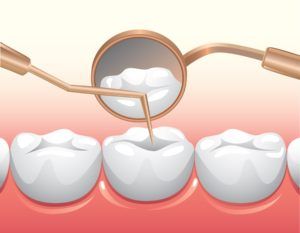
Your general dental appointment will likely begin with dental x-rays. Dental x-rays are an important diagnostic tool that provides information about your jaw bones, bite alignment, the presence of possible wisdom teeth, and any possible cavities that are not immediately visible. During your dental x-rays, you will be given a plastic piece to bite down on, and several different angles will likely be taken. Although dental x-rays do emit radiation, this amount is so low that they are considered safe for both children and adults.
During your dental exam, Dr. Claudia Wood will evaluate your teeth, bite, and gums. She will use special tools to test your teeth for sensitivity or possible decay. She will also measure your gum pockets and look for signs of gum disease and recession. Your bite will also be evaluated in terms of alignment and function. After your dental exam is over, Dr. Wood will discuss her findings from the dental exam and x-rays, and answer any questions you may have.
Following your dental exam, you will have a professional teeth cleaning. Your professional teeth cleaning will begin with the removal of plaque and tartar from the surface of your teeth. Using a special tool, called a scaler, Dr. Wood will carefully scrape away any buildup on your teeth. Then, she will brush on a gritty mixture to remove any remaining debris. Once this mixture is rinsed, your teeth will be professionally flossed and then a fluoride polish will be brushed onto the surface of your teeth.
If Dr. Wood found a need for restorative treatment, you may also have a restorative procedure done at this same appointment, or it may be scheduled for another time. Before any treatment is carried out, it will be thoroughly explained to you so that you are well informed.
What can I expect after having general dental care?
Depending on the type of services you had, you may be given special instructions to follow after your treatment. If this is the case, it is very important to follow all these directions in order to obtain the best results. In addition to any special instructions, you will also want to maintain a good oral hygiene routine. This should consist of brushing twice daily for two minutes with a fluoridated toothpaste, as well as flossing once daily.
How much is general dental care?
The cost of general dental care depends on whether your treatment is preventative, restorative, or cosmetic. Preventative dental treatment is the most affordable type of general dental treatment and is generally covered by most dental insurance companies. Restorative treatment can be more expensive than preventative care, and the total cost will depend on the type and extent of treatment. Generally, dental insurance companies will offer partial coverage for restorative treatments. Cosmetic dental treatments have a range of costs depending on the type and extent of treatment as well. However, many dental insurance companies do not cover cosmetic dental treatments.
For dedicated and caring dental care, schedule a consultation with Dr. Claudia Wood of Danforth Dental Solutions. Danforth Dental Solutions is proud to serve Toronto and the surrounding areas.

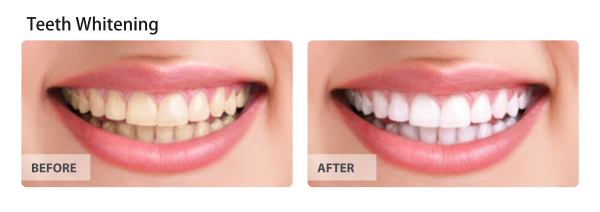
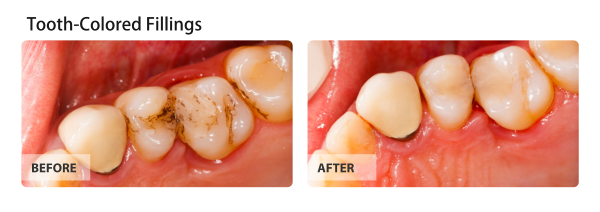

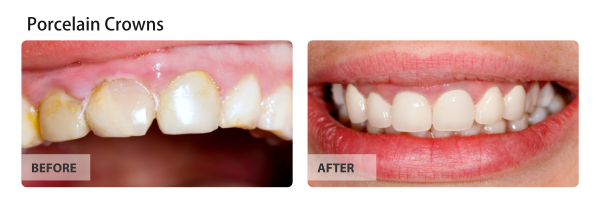

Do you love drinking coffee, tea, or wine? As a result have your teeth become stained or less white than they used to be? Are you looking for a simple way to brighten your smile? Then teeth whitening services at Danforth Dental Solutions may be a great cosmetic dental option for you! Professional teeth whitening is a cosmetic dental procedure that removes stains from your teeth and restores their beautiful, white color. In only a single dental appointment, professional teeth whitening can brighten your smile up to 10 shades lighter!
Did You Know?
Your teeth stain as a natural part of aging. Because of this, no matter how great your oral hygiene habits are, your teeth will begin to look discolored as you get older.
Frequently Asked Questions:
Am I a candidate for professional teeth whitening at Danforth Dental Solutions?
You may be a candidate for professional teeth whitening at Danforth Dental Solutions if you have stained or discolored teeth that you wish to brighten. Additionally, ideal candidates for teeth whitening do not have any cavities, gum disease, and have good dental health. You may also be a candidate for teeth whitening if you are having a permanent restoration, such as a dental crown or veneers, placed and want to whiten the rest of your smile to match your restoration. To find out if professional teeth whitening is the right service for you, schedule a consultation with Dr. Claudia Wood of Danforth Dental Solutions today!
Will professional teeth whitening remove all the stains from my teeth?
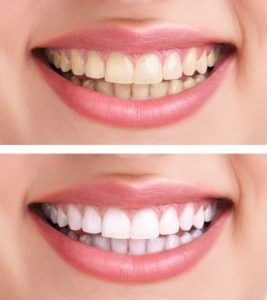
There are two types of stains that cause your teeth to become discolored: extrinsic and intrinsic. Extrinsic stains are generally caused by external factors such as your oral health routine and highly pigmented foods or beverages. Extrinsic stains refer to any stains on the enamel, or outermost layer. Intrinsic stains are stains that appear on the dentin layer just under the enamel. Intrinsic stains are the result of aging, certain medications, and excessive fluoride.
Professional teeth whitening services are designed to remove stains from both the enamel and dentin layer. Generally, hydrogen peroxide or carbamide peroxide are used to trigger an oxidation reaction within the layers of your teeth, essentially breaking the bonds responsible for holding discolored molecules together. By breaking these bonds, the molecules disappear and your teeth are returned to their natural, white color. However, your individual results will depend on how well your teeth respond to treatment and how bad your stains are. In some cases, teeth whitening procedures may have to be repeated to get the desired results.
What happens when I visit Danforth Dental Solutions for professional teeth whitening?
Before beginning your teeth whitening procedure, Dr. Wood will first give you a professional teeth cleaning to remove any debris from your teeth. Not only is this important to remove bacteria from your mouth, but also to create a smooth surface for the whitening agents to work on. Once your cleaning is completed, your whitening goals will be discussed and a shade guide may be used to help you select your desired shade.

As a precautionary measure, Dr. Wood will cover your gums before applying the whitening agent to your teeth. Then, the whitening agents will be applied to your teeth and left for about an hour. The whitening agent may be placed in some kind of tray or it may simply be brushed onto the surface of your teeth. After an hour, the remaining whitening agents will be suctioned off, your mouth will be rinsed, and your teeth will be polished.
What happens after professional teeth whitening?
After your teeth whitening appointment, you will need to avoid consuming highly pigmented substances for the first 24 hours to avoid staining your teeth. This is because the whitening agents will continue to work for the first 24 hours, so additional stains will limit the stains they can remove. After your professional teeth whitening appointment, you may also notice some minor tooth sensitivity. This is normal and should get better within a few days.
What will happen to my fillings and/or dental crowns when I have my teeth whitened?
Nothing will happen to your fillings and/or dental crowns when you have your teeth whitened. This means that they will remain exactly as they are and they will not lighten with the rest of your natural teeth. If your restoration is not immediately visible, this probably won’t cause any problems. However, if your restoration is visible, the color difference may be noticeable. To avoid this, consider having your teeth whitened before you have your final restoration placed or make plans to replace your restoration after your teeth have been whitened.
How long does teeth whitening last?

Unfortunately teeth whitening does not last forever and your teeth will eventually stain again. Most teeth whitening treatments last for about six months to a year, depending on how well you avoid staining your teeth. However depending on other factors, like ageing or medications, your teeth may become stained sooner rather than later. After you have your teeth whitened, talk with Dr. Wood on how to make your results last as long as possible. Some general guidelines to follow include brushing your teeth with a whitening toothpaste, avoid smoking, and limit pigmented beverages like tea, wine, and coffee. You will also want to maintain good oral habits such as brushing twice a day for two minutes at a time, flossing once a day, and visiting Danforth Dental Solutions twice a year for your professional teeth cleaning.
How much does teeth whitening cost?
The cost of your professional teeth whitening cost will depend upon your individual case and whitening goals. However, a general number for most in-office whitening treatments is about $650. To help cover the cost of professional teeth whitening, you may be able to get financing options.
For dedicated and caring dental care, schedule a consultation with Dr. Claudia Wood of Danforth Dental Solutions. Danforth Dental Solutions is proud to serve Toronto and the surrounding areas.
Dental veneers – also known as laminates – are used to cosmetically enhance the appearance of one or more teeth. Veneers are very thin, porcelain or resin shells that are customized for a desirable color and shape. They are bonded to the surface of the teeth to reshape broken, misshapen or irregular teeth, as well as provide a solution for discolored teeth that do not respond to traditional whitening treatments. Patients with veneers typically achieve a natural tooth appearance that is well-tolerated by the gums and also resistant to future stains.
Did you know…
that dental veneers are a conservative way of completely making over your smile? In fact, veneers are a go-to cosmetic procedure that has become popular with celebrities who want a brighter and more symmetrical smile. Miley Cyrus, Hilary Duff and Ben Affleck are just some of Hollywood’s elite who have seen a cosmetic dentist for laminates. Fortunately, affordability and accessibility make it easy for anyone to get dental veneers – including patients.
Frequently Asked Questions
Am I a candidate for dental veneers or laminates?
Dental veneers may be right for you if you are looking for an alternative to crowns and caps. Veneers can help you if you have gaps between your teeth or teeth that are broken, chipped, irregularly shaped or misaligned. To find out more about whether dental veneers are right for you, contact a cosmetic dentist to schedule a consultation.
What should I expect when I get my dental veneers?
Before dental veneers can be placed on the teeth, the surface of the teeth must be prepared for bonding. After administering a local anesthetic, your dentist will buff away approximately half a millimeter from the surface of the teeth. You’ll then bite into a mold that will be used to form your veneers in a dental lab. When the veneers are ready, you’ll be asked to return to have them fitted, bonded and adjusted for shape and color.
Will I need to follow any post-treatment care instructions?
There is no special care required for dental veneers, and normal brushing and flossing can be resumed immediately. Because veneers are usually placed over the course of two appointments, it is normal to experience some sensitivity between the first and second visit when the teeth have been reduced in preparation for bonding.
TMJ refers to the temporomandibular joint, which is the bone structure, muscles and connective tissues that surround the jaw and control chewing. When patients experience disorders of this joint, they are said to have a temporomandibular joint disorder or TMD. Symptoms of TMD include pain and tenderness near the jaw, as well as popping or clicking in the joint when speaking or chewing. There are many ways of treating TMJ disorders, ranging from non-invasive therapy and bite splints to injections or surgery. Left untreated, however, TMJ disorders can lead to headaches, muscle pain, malocclusion and tooth damage from grinding or clenching.
Did you know…
that TMD alone is not a disorder, but instead a collection of disorders that affect the temporomandibular joint? It is the second most common pain-causing musculoskeletal condition in the U.S. according to the U.S. National Institute of Dental and Craniofacial Research, as many as 12 percent of Americans may suffer from some type of TMD, with women twice as likely to be affected than men. But despite the prevalence and wide availability of treatment, only one out every three people with TMD fails to seek treatment.
Frequently Asked Questions
How do I know if TMJ treatment is right for me?
You will first need to be formally examined and diagnosed with TMJ disorder. You dentist will evaluate the extent of the condition and determine what course of treatment is best for you. Usually, the initial approach involves conservative treatments, such as self-care, physical therapy and bite guards. Medications may also be used to relax the jaw or relieve pain. Patients who do not respond to conservative treatments may be considered for surgery or joint injections.
What should I expect if I undergo treatment for TMJ
TMJ treatment varies from patient to patient, so your experience may be very different than someone else’s. You’ll probably be asked to adopt certain lifestyle changes to help facilitate rehabilitation in your jaw. For example, you may be asked to avoid sudden jaw movements, such as yelling or yawning. You may also need to begin sleeping on your back and take steps to reduce your stress levels.
Will I need to follow any special post-care instructions while being treated for TMJ?
Your post-treatment care instructions will vary according to the type of treatment you receive. If you undergo an aggressive treatment, such as surgery, you may be temporarily subject to an all-liquid diet. You’ll also need to apply ice to the face to minimize swelling and also keep the surgical site clean and dry.
Root canal treatment is required when the tooth’s pulp and roots are infected. Often times, this infection is the result of untreated tooth decay that has reached the innermost layer of the tooth. Infected pulp can cause tooth pain, swelling, and overall discomfort. By removing the infected tissue, root canal treatment restores the affected tooth and prevents it from eventual loss.
Did You Know?
Root canal treatments restore about 17 million teeth each year. By removing the diseased tissue, root canals prevent the need for a tooth extraction. This means that root canal treatment is also responsible for saving 17 million teeth each year.
Frequently Asked Questions:
Do I need root canal treatment?
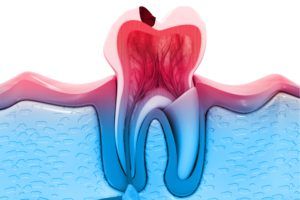
You will need root canal treatment if your tooth’s pulp has become infected. Symptoms indicating the need for root canal treatment can include:
- Painful toothache (mild to severe)
- Swollen or inflamed gum tissue around the affected tooth
- Inability to chew or apply pressure to the affected tooth
- The tooth appears discolored
- Temperature sensitivity to hot and cold
Any of these symptoms could indicate a possible pulp infection and should be evaluated immediately. If you are experiencing any of these symptoms, schedule a consultation with Dr. Claudia Wood of Danforth Dental today.
Are root canals painful?
Although most people believe root canal treatment to be painful, root canals themselves are not painful. Rather it is the pulp infection that causes pain. Consider this. The pulp layer of your tooth contains nerves, blood, and lymph tissue. When it becomes infected, the pulp starts to die which triggers an inflammatory response from the body. This inflammatory response is the reason why your tooth starts hurting. Although root canals remove the infected tissue, it still takes a few days for the inflammation to go down. This means there may be some residual pain. However, this pain is the result of the previous infection, not root canal treatment. In fact, during your root canal treatment, you will be anesthetized and your mouth will be numb.
What causes pulp infections?
The most common cause for pulp infections are tooth decay. Your teeth have three layers: the enamel, dentin, and pulp layer. Enamel is the strongest layer, followed by dentin, and the pulp is the internal core. Enamel and dentin protect the pulp, however when tooth decay is able to permeate through these layers, bacteria is able to enter the pulp and cause an infection.
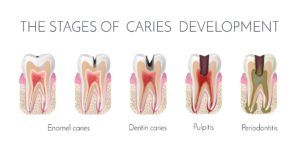
Although tooth decay is the most common reason, trauma resulting in a crack or chip can also allow bacteria to enter the pulp. Leaky fillings, crowns, or other dental restorations can also allow bacteria to enter the pulp.
Is there an alternative to root canal treatment?
The only alternative to root canal treatment is to have the infected tooth extracted. Once the pulp has become infected, the tooth can only be saved by removing the infection through a root canal or removing the tooth altogether. However, extractions are not often recommended because they are more invasive and costly. Root canal treatment is currently the safest and most effective way to remove infected pulp while preserving the tooth.
How is root canal treatment performed?
Before beginning your root canal procedure, Dr. Wood will take x-rays to determine the extent of the infection. She will then prepare your tooth for the procedure by isolating it with a dental dam. This makes the tooth easier to treat and prevents saliva from entering the treatment area. Your mouth will also be anesthetized with a local anesthetic to keep you comfortable during the procedure. In some cases, local anesthesia may also be used to keep you calm and still.
Once your tooth has been prepared and your mouth is numb, a small hole will be drilled in the top of your tooth in order to reach the pulp layer. Then, specialized root canal files will be inserted into the pulp chamber and root canals to remove the tooth’s nerve and the infected pulp tissue. After all the infected tissue has been removed, the remaining space will be flushed with water or sodium hypochlorite, which is an antiseptic. This will remove any additional debris and ensure that the pulp chamber and root canals are free of bacteria.
The remaining chamber and root canals will then be filled with a rubber-like material called gutta-percha. This root canal filling material is used to provide internal support for the tooth. Sometimes, a special post may also be placed inside the tooth to provide even more support. Root canal treatment is then concluded by placing a temporary filling over the gutta-percha. This temporary filling effectively seals the tooth until a permanent restoration can be placed.
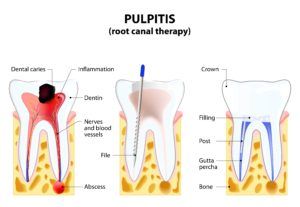
Are there any post-treatment instructions I need to follow?
Yes, you will have certain post-treatment instructions to follow. After your root canal, you will need to avoid chewing on the side the procedure was performed on until a permanent restoration can be placed. Usually a dental crown will be placed once it is clear that your tooth has healed properly. It is important to have the dental crown placed as soon as possible.
You may also experience some minor soreness after root canal treatment. This is because the area is still inflamed from the initial infection. Any pain or soreness should fade within a few days once the inflammation heals. In the meantime, you can use over the counter pain medications if needed.
In some cases, root canal retreatment may be necessary if the tooth fails to heal or becomes infected again. Sometimes the tooth may not heal properly because it contained narrow or crooked canals that were not completely cleaned. Other times, the tooth can become infected in the future due to trauma, decay, or a faulty dental restoration.
How much do root canals cost?
The average cost of a root canal is about $500-$1,800. Root canals in molars tend to be on the more expensive end because the procedure is more difficult. There is also an additional cost for the dental crown, however this can vary depending on the materials used.
With dental insurance, you can expect partial coverage. Dental insurance plans classify root canal treatment as a restorative procedure and will often pay a percentage of the total cost. This amount will depend on your individual insurance company and our office will help you to determine what your level of coverage is before undergoing root canal treatment.
For dedicated and caring dental care, schedule a consultation with Dr. Claudia Wood of Danforth Dental Solutions. Danforth Dental Solutions is proud to serve Toronto and the surrounding areas.
Inlays and onlays are dental restorations that are more extensive than dental fillings but less so than caps and crowns. They are typically formed in a dental lab and are made of gold, porcelain or resin depending on the patient’s needs and aesthetic goals. An inlay refers to a restoration that is formed to fit the center of a tooth, whereas an onlay refers to a restoration that encompasses at least, one cusp of the tooth. Both inlays and onlays are bonded to the surface of damaged teeth and matched to the color of the surrounding teeth.
Did you know…
that inlays and onlays can serve as alternative treatments to dental crowns when you have a broken or damaged tooth? When fillings are not enough to adequately repair a tooth, an inlay or onlay can be custom-created to fit securely onto the tooth’s surface. Depending on the materials used, the restoration can be created to appear natural and will have the same function of an organic tooth. Inlays and onlays have extremely high success rates and because they are custom made for each patient, most last longer than traditional fillings.
Frequently Asked Questions
Am I a candidate for an inlay or onlay?
You could be a candidate for an inlay or onlay in if you have moderate tooth damage or decay and are in search of an alternative restoration option to a crown or cap. Schedule a dental consultation for a complete examination and to find out if an inlay or onlay is right for you.
What should I expect when I get my inlay or onlay restoration?
Your inlay or onlay restoration will be completed over multiple dental treatments. First, your tooth will be prepared for treatment, and an impression will be taken to serve as a mold for your new restoration. You may be fitted with a temporary restoration while your permanent inlay or onlay is fabricated. Once completed, you will return to have the temporary restoration removed and the permanent one bonded to the surface of the teeth.
Do I need to follow any post-treatment care guidelines?
Special care needs to be given to your teeth while temporary restorations are in place. It is important to avoid sticky or hard foods that could cause significant damage to temporaries. Once you receive your permanent inlay or onlay, you can resume normal eating, brushing and flossing habits.
Dental implants are a common dental restoration used to restore damaged, decayed, or missing teeth. There are two different types of dental implants: subperiosteal and endosteal. Subperiosteal implants sit on top of the jawbone below the gum line. Because they are not implanted into the jawbone, they lack the strength of endosteal implants and are not often used.
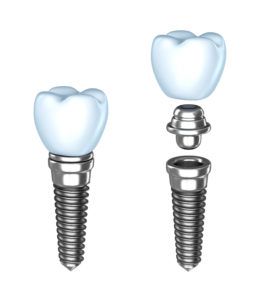
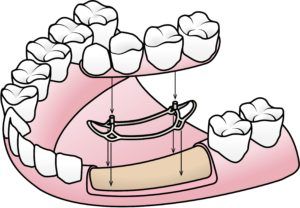
Endosteal implants, on the other hand, are composted of titanium screws that are implanted into the jawbone. Once healed, endosteal implants fuse with the surrounding bone and act as artificial tooth roots that can support a dental prosthesis. When most dentists refer to “dental implants” they are usually referring to endosteal implants, or traditional dental implants. Endosteal implants are able to offer strength, increased aesthetics, and restored tooth function.
Once placed, dental implants can support a dental prosthesis such as a dental crown, bridge, or implant supported dentures. Dental crowns are generally used to restore single teeth, while a dental bridge can restore multiple teeth. In cases where large amounts of teeth or a full arch needs to be restored, implant supported dentures may be placed.
Did You Know?
A traditional dental implant is composed of three different pieces. The implant screw is the first piece that is embedded into the jawbone and acts as an anchor. The next piece is the abutment, or connector, which screws into the implant and allows for the mounting of a dental prosthesis, which is the final piece.
Frequently Asked Questions:
Am I a candidate for dental implants?
You may be a candidate for dental implants if you have teeth that are severely decayed or damaged. Additionally, you may also be a candidate for dental implants if you have missing teeth or teeth that need to be extracted due to damage or decay.
Ideal candidates for dental implants also have adequate bone mass surrounding the proposed implant area. If your teeth have been missing for longer than six months, you may or may not have enough bone mass for dental implants. However, this doesn’t necessarily mean that you cannot have dental implants. Only a consultation with Dr. Claudia Wood of Danforth Dental can determine your eligibility. To determine if dental implants are an ideal dental treatment choice for you, schedule a consultation today!
What if I am lacking adequate bone mass?
As mentioned before, if you are lacking bone mass it doesn’t necessarily mean that you cannot have dental implants. Depending on your individual situation, Dr. Wood may recommend one of the following treatments to replenish lost bone mass.
Bone Graft:
A bone graft works to increase the bone mass of a certain area by placing bone material at the desired area. This bone material can be harvested from your own body or can be artificially produced in a lab. Once implanted, the bone material will eventually grow into new, healthy bone in about 3-6 months. In some cases, bone grafts are completed before implant placement and in other cases, a bone graft can be completed at the same time as implant placement.
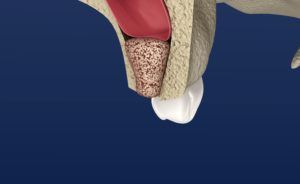
Sinus Lift:
A sinus lift is a specialized bone graft that is performed on the top of the mouth (maxilla). Because your sinus cavity sits just above your upper jaw, the purpose of a sinus lift is to add bone between your teeth and your sinus cavity to ensure that the implant cannot damage the sinus cavity. Just like a bone graft, bone material is added to the area and left to grow into new bone.
Ridge expansion:
Ridge expansions are not as common as bone grafts or sinus lifts, but they offer a solution for those who have extremely small or narrow mouths that do not have enough room to accommodate a dental implant. During a ridge expansion, bone material is placed at an incision in the top of the mouth to cause bone to grow and widen the palate.
What can I expect when having dental implants placed?
The dental implant placement process is usually completed with multiple appointments. A consultation is usually the first step of the process. During your initial consultation, Dr. Wood will perform an examination of your teeth, gums, and bite. She may also take dental x-rays to determine how much bone mass you have. Using this information, she will design a treatment plan for your individual case.
If you choose to move forward with treatment, you will return on a different day to have your implants placed. The implant placement procedure is a minor oral surgery, so you will be anesthetized and sedated to keep you comfortable and relaxed.
The implant procedure begins with a small incision being made in the gums to access the jawbone. Then a series of drills will be used to drill and shape a hole in the jaw bone for the implant. Finally, the implant screw will be screwed into place and the gums will be sutured shut over it.
In some cases, the abutment may be connected to the implant screw. If this is the case, the abutment will protrude above the gum line and the gums will be sutured around it. In other cases, such as with immediate load or teeth in a day implants, a temporary dental prosthetic will also be attached.
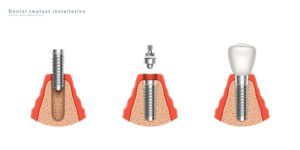
With the exception of immediate load implants, most dental implants require a healing period of about 3-6 months before the abutment and/or dental prosthesis can be attached. During this healing period, a process called osseointegration occurs. Osseointegration is the fusing of the implant screw to the surrounding bone and is a necessary part of implant success.
Once the bone has fused with the implant, another procedure will be performed to place the abutment and a temporary dental prosthesis. A dental impression or digital scan will then be taken of the mouth and sent to a dental laboratory for the fabrication of the final dental prosthesis. Once the permanent restoration has been fabricated, it will be placed in the mouth, checked for color and fit, and permanently cemented. This completes the implant process.
What can I expect after undergoing dental implant placement?
After undergoing dental implant placement, you may experience some soreness. Usually any discomfort can be remedied with over the counter pain medications and ice. In the first 48 hours following your procedure, it is recommended to use ice for 15 minutes on and 15 minutes off. After 48 hours, heat can be used for 20 minutes on and 20 minutes off.
You will also need to temporarily modify your diet until your implant heals. In the days following your procedure, you will want to stick to cool, soft foods. As you start to recover, Dr. Wood will discuss what types of foods you can eat without causing damage to your implant.
Finally, you will need to keep the treatment site clean and free of debris. After your procedure, you will be provided with specific directions on how to do this. For the best results, it is important that you follow these instructions as well as those pertaining to pain management and diet.
For dedicated and caring dental care, schedule a consultation with Dr. Claudia Wood of Danforth Dental Solutions. Danforth Dental Solutions is proud to serve Toronto and the surrounding areas.






